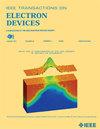极化增强e型GaN p-FET及互补逻辑(CL)电路的设计与开发
IF 2.9
2区 工程技术
Q2 ENGINEERING, ELECTRICAL & ELECTRONIC
引用次数: 0
摘要
氮化镓(GaN)层中Mg受体的低电离率是导致e型氮化镓p-场效应管电流密度低的关键因素。本研究采用极化增强技术来提高p-GaN通道的电离速率。为了实现GaN互补逻辑(CL)电路,制备了高性能的嵌入式栅极e模GaN p- fet。在制造过程中,发现通道厚度(${t}_{x}$)是影响器件度量的关键参数。随着${t}_{x}$的减小(即凹槽深度的增大),可以获得更负的阈值电压(${V}_{\text {th}}$);然而,代价是增加${R}_{\text {on}}$。${t}_{x} =32$ nm的e模GaN p-FET显示${V}_{\text {th}}$为−1.1 V,高电流密度为17.7 mA/mm,高${I}_{\text {on}}$ / ${I}_{\text {off}}$为$6.9\ × 10^{{7}}$,低亚阈值摆幅(SS)为93 mV/dec。此外,在相同的外接晶圆上制备了一个e模n通道p-GaN栅极高电子迁移率晶体管(HEMT),其电压为${V}_{\text {th}}$为1.3 V,电压为${R}_{\text {on}}$为$6~\mathrm {\Omega \cdot}$ mm。最后,在${V}_{\text {DD}} =6$ V的条件下,制备了GaN CL逆变器并进行了演示。这项工作进一步验证了GaN CL集成电路和功率集成电路(PICs)的可行性。本文章由计算机程序翻译,如有差异,请以英文原文为准。
Design and Development of Polarization-Enhanced E-Mode GaN p-FET and Complementary Logic (CL) Circuits
The low ionization rate of Mg acceptors in the p-gallium nitride (GaN) layer is a critical factor accounting for the low current density of E-mode GaN p-FETs. In this work, polarization-enhanced technology was adopted to enhance the ionization rate of the p-GaN channel. High-performance recessed-gate E-mode GaN p-FETs were fabricated to enable GaN complementary logic (CL) circuits. During fabrication, the channel thickness ( ${t}_{x}$ ) is found to be a critical parameter that influences the device metrics. With a decrease in ${t}_{x}$ (i.e., larger recess depth), a more negative threshold voltage ( ${V}_{\text {th}}$ ) is achieved; however, the trade-off is an increase in ${R}_{\text {on}}$ . The E-mode GaN p-FET with ${t}_{x} =32$ nm exhibits a ${V}_{\text {th}}$ of −1.1 V, a high current density of 17.7 mA/mm, a high ${I}_{\text {on}}$ / ${I}_{\text {off}}$ of $6.9\times 10^{{7}}$ , and a low subthreshold swing (SS) of 93 mV/dec. Furthermore, an E-mode n-channel p-GaN gate high electron mobility transistor (HEMT) was fabricated on the same epi-wafer, exhibiting a ${V}_{\text {th}}$ of 1.3 V and an ${R}_{\text {on}}$ of $6~\mathrm {\Omega \cdot }$ mm. Finally, a GaN CL inverter was fabricated and demonstrated under ${V}_{\text {DD}} =6$ V. Rail-to-rail voltage swing and low static power consumption were both achieved. This work further validates the feasibility of GaN CL integrated circuits and power integrated circuits (PICs).
求助全文
通过发布文献求助,成功后即可免费获取论文全文。
去求助
来源期刊

IEEE Transactions on Electron Devices
工程技术-工程:电子与电气
CiteScore
5.80
自引率
16.10%
发文量
937
审稿时长
3.8 months
期刊介绍:
IEEE Transactions on Electron Devices publishes original and significant contributions relating to the theory, modeling, design, performance and reliability of electron and ion integrated circuit devices and interconnects, involving insulators, metals, organic materials, micro-plasmas, semiconductors, quantum-effect structures, vacuum devices, and emerging materials with applications in bioelectronics, biomedical electronics, computation, communications, displays, microelectromechanics, imaging, micro-actuators, nanoelectronics, optoelectronics, photovoltaics, power ICs and micro-sensors. Tutorial and review papers on these subjects are also published and occasional special issues appear to present a collection of papers which treat particular areas in more depth and breadth.
 求助内容:
求助内容: 应助结果提醒方式:
应助结果提醒方式:


